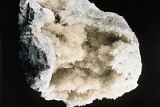
Colemanite
Encyclopedia
Colemanite is a borate
mineral
found in evaporite
deposits
of alkaline lacustrine
environments. Colemanite is a secondary mineral that forms by alteration of borax
and ulexite
.
It was first described in 1884 for an occurrence near Furnace Creek
in Death Valley
and was named after William Tell Coleman
(1824–1893), owner of the mine Harmony Borax Works where it was first found. At the time, Coleman had alternatively proposed the name "smithite" instead after his business associate Francis Marion Smith
.
Borate
Borates are chemical compounds which contain oxoanions of boron in oxidation state +3. The simplest borate ion, BO33−, has a trigonal planar structure. Other borates are made up of trigonal BO3 or tetrahedral BO4 structural units, sharing oxygen atoms...
mineral
Mineral
A mineral is a naturally occurring solid chemical substance formed through biogeochemical processes, having characteristic chemical composition, highly ordered atomic structure, and specific physical properties. By comparison, a rock is an aggregate of minerals and/or mineraloids and does not...
found in evaporite
Evaporite
Evaporite is a name for a water-soluble mineral sediment that result from concentration and crystallization by evaporation from an aqueous solution. There are two types of evaporate deposits, marine which can also be described as ocean deposits, and non-marine which are found in standing bodies of...
deposits
Deposition (geology)
Deposition is the geological process by which material is added to a landform or land mass. Fluids such as wind and water, as well as sediment flowing via gravity, transport previously eroded sediment, which, at the loss of enough kinetic energy in the fluid, is deposited, building up layers of...
of alkaline lacustrine
Lake
A lake is a body of relatively still fresh or salt water of considerable size, localized in a basin, that is surrounded by land. Lakes are inland and not part of the ocean and therefore are distinct from lagoons, and are larger and deeper than ponds. Lakes can be contrasted with rivers or streams,...
environments. Colemanite is a secondary mineral that forms by alteration of borax
Borax
Borax, also known as sodium borate, sodium tetraborate, or disodium tetraborate, is an important boron compound, a mineral, and a salt of boric acid. It is usually a white powder consisting of soft colorless crystals that dissolve easily in water.Borax has a wide variety of uses...
and ulexite
Ulexite
Ulexite , sometimes known as TV rock, is a mineral occurring in silky white rounded crystalline masses or in parallel fibers. The natural fibers of ulexite conduct light along their long axes, by internal reflection...
.
It was first described in 1884 for an occurrence near Furnace Creek
Furnace Creek
Furnace Creek may refer to:Populated places*Furnace Creek, California in Inyo CountyStreamsCalifornia*Furnace Creek in Mono County*Furnace Creek Wash Inyo CountyGeorgia*Furnace Creek in Walker County...
in Death Valley
Death Valley
Death Valley is a desert valley located in Eastern California. Situated within the Mojave Desert, it features the lowest, driest, and hottest locations in North America. Badwater, a basin located in Death Valley, is the specific location of the lowest elevation in North America at 282 feet below...
and was named after William Tell Coleman
William Tell Coleman
William Tell Coleman was an American pioneer. He was born in Cynthiana, Harrison County, Kentucky, and was educated at St. Louis University.-Committees of Vigilance:...
(1824–1893), owner of the mine Harmony Borax Works where it was first found. At the time, Coleman had alternatively proposed the name "smithite" instead after his business associate Francis Marion Smith
Francis Marion Smith
Francis Marion Smith was an American miner, business magnate and civic builder in the Mojave Desert, the San Francisco Bay Area, and Oakland, California.Frank Smith created the extensive interurban public transit Key System in Oakland, the East Bay,...
.

